I truly believe that travel broadens perspectives, and I do my best to practice what I preach. So, when the opportunity came up to travel with Accor Hotels and Turkish Airlines to Cairo and Istanbul, I jumped at the chance. It may seem strange (or even imprudent) for a young American female to jet off to two countries whose reputations are less than stellar in the average American mindset, but I wanted experience these destinations for myself – and to bring back first-hand knowledge about the reality of the situation.
Before I get into the details of the trip itself, I would like to start out by saying that I felt perfectly safe in both locations. Granted, I was with a guided group the whole time, not traveling by myself, but at least in Egypt, we would never recommend going around without a guide and car/driver. There isn’t a real centralized “downtown” that has most of the attractions – they’re all quite spread out – so you’d have to take taxis anyway if you didn’t have private transportation (I believe Uber also works in Cairo, but I cannot speak to its reliability having not used it myself). That was not the case in Istanbul – I felt that even if I were by myself taking in the sights, I would be perfectly comfortable walking around solo or with a couple friends. Political issues aside (in both countries sadly, although Turkey more so), I don’t have any reason not to recommend these two destinations to anyone – especially those travelers interested in different cultures or histories than their own.
And away we go!
Friday, October 13th / Saturday, October 14th
As is my custom, I headed out to Chicago O’Hare a good 4 hours prior to flight time – while I know hanging out at the airport is not anyone’s idea of a good time, I find the best remedy for flight anxiety is to schedule ample time for any unforeseen circumstances (long lines for check-in or bag drop, less than speedy TSA agents, forgotten items, etc). The worst that can happen is that you have to sit at your gate for a while – bring a book!
Our flight was scheduled to depart at 9:40 pm, and I was able to the check-in at around 6:30 pm. Check-in was speedy (one of the perks of flying Business Class is you get your own check-in line) — passport control and security was less so. I guess I’ve gotten spoiled with my recent domestic trips having Global Entry and TSA Pre-Check, but it certainly seemed to me that there were an awful lot of people with no idea how to properly go through screening procedures…
Anyway, by the time I got through screening, and got my shoes back on I had about an hour before boarding started – so I made my first trip to the Swissport Lounge (the lounge for Turkish Airlines, Emirates, Hainan and Finnair). Not being a frequent lounge goer, the space was adequate enough to charge my phone and computer, get a bit of free wifi, and grab a snack, but I wouldn’t rave about it. It serves a purpose, but don’t expect anything super special!
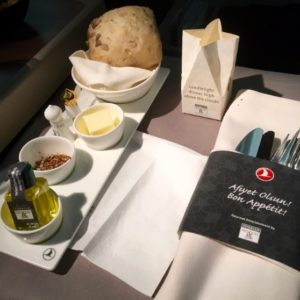 Cut to the flight itself: I have never flown Business Class (on any airline) prior to this trip, so my review may be a bit skewed, but I found it to be quite good! It took me a bit to get over the feeling that I was a clear impostor to such a luxurious flight experience – most of it due to the fact that I was not really sure how the seat and all its fancy gadgets worked – but once we were in the air I think I had adjusted pretty well! In my humble opinion, the service was very good – very attentive crew and a good selection of food and beverage options. The lie-flat seat and bedding was comfortable enough for sleeping – I’m a side-sleeper and I had ample room. I’ve never been able to sleep on planes so even just getting 4-5 hours was nice!
Cut to the flight itself: I have never flown Business Class (on any airline) prior to this trip, so my review may be a bit skewed, but I found it to be quite good! It took me a bit to get over the feeling that I was a clear impostor to such a luxurious flight experience – most of it due to the fact that I was not really sure how the seat and all its fancy gadgets worked – but once we were in the air I think I had adjusted pretty well! In my humble opinion, the service was very good – very attentive crew and a good selection of food and beverage options. The lie-flat seat and bedding was comfortable enough for sleeping – I’m a side-sleeper and I had ample room. I’ve never been able to sleep on planes so even just getting 4-5 hours was nice!
We arrived in Istanbul on time, and once I met up with the other members of our group we had a little over two hours before our connecting flight to Cairo. We did not get to use the lounge facilities as we were booked in Economy on the Istanbul-Cairo leg of the trip, but all the better to get a sense of the airport as seen by the average passenger, no? While quite busy, the International Terminal is clean and “user-friendly”, and offers a wide variety of dining and shopping options. If you’re going to be there for more than 2 hours, I would recommend finding a spot away from the main shopping/dining terminal to set up shop as that area is right after passport control and it seems like everyone just stops there.
We boarded our flight to Cairo by bus (which I always find slightly annoying as I don’t think it’s the most efficient use of time – especially when they clearly don’t board by groups). Service in Economy was good – they were flying an Airbus 321 so everyone had their own entertainment screen – and they served a hot meal. Being that I mostly fly American carriers domestically, I’m still not used to getting meals on what I consider short flights (even if they’re international), but I really do think that it adds to the experience. It may not be high-quality food, but something a little more than pretzels to tide you over goes a long way in preventing cranky customers….
By the time we landed in Cairo it was already after 8 pm local time, so I was very much hoping that the immigration/customs/getting baggage procedure would be quick. We had decided as a group to get our visas on arrival, and the process was even easier than I remember from last time I went to Egypt. There are no official visa desks (or really any signs), but all you have to do to get a visa is go to one of the bank/currency exchange counters, hand them US$ 25 in cash, and they hand you a sticker to put in your passport. Not really the most official procedure (I don’t think anyone even looked at my passport), but an effective-enough money making process.
As we had our on-site reps meet us BEFORE immigration, we finagled our way to the priority immigration lane, picked up our bags, and went through customs within 20 minutes. Not bad at all! Definitely worth the VIP Meet & Greet/Fast Track surcharge.
Once we piled on our minibus with all our luggage, we were off to the Fairmont Nile City. The drive took about 40 minutes and during that time our Egitalloyd coordinator. Mohammad gave us a brief overview of Cairo, the basic outline of our itinerary, and answered any preliminary questions we had about travel and tourism to Egypt. Understandably, since the 2011 Arab Spring, tourism to Egypt has dropped off pretty sharply from the US market. Numbers have been climbing since 2015, and the Egyptian infrastructure, financial institutions, and luxury tourism is bouncing back, although not at pre-2011 levels.
We finally arrived at our hotel, the Fairmont Nile City, at around 10pm, where we were met by a squadron of over 20 employees, from the Egyptian Regional Director to the Sales staff, to the Guest Services members. They literally welcomed us with open arms – and each member of our group was assigned to a staff member to be escorted to our rooms.
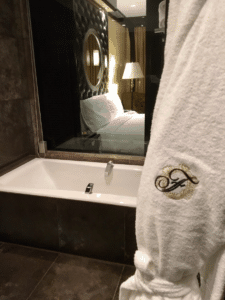 We were each given a Deluxe Nile Room, the 3rd of 4 categories in the property (the first 3 categories have the same square footage, but different views – city view, partial Nile view, and full Nile view). At around 350 square feet, the room was large enough for 1-2 people and their luggage to fit comfortably. However, when we went on our site inspection, the rooms we saw were much brighter and had lighter tiling and accents — we were told that the rooms with 2 beds always have a white headboard and different linens (with pops of color) — which seems odd that they would have different decor based on the number of beds. Basically, the room product is good, as long as you aren’t picky about decor, because honestly, I could not tell if there’s really any consistency between rooms from what we were shown.
We were each given a Deluxe Nile Room, the 3rd of 4 categories in the property (the first 3 categories have the same square footage, but different views – city view, partial Nile view, and full Nile view). At around 350 square feet, the room was large enough for 1-2 people and their luggage to fit comfortably. However, when we went on our site inspection, the rooms we saw were much brighter and had lighter tiling and accents — we were told that the rooms with 2 beds always have a white headboard and different linens (with pops of color) — which seems odd that they would have different decor based on the number of beds. Basically, the room product is good, as long as you aren’t picky about decor, because honestly, I could not tell if there’s really any consistency between rooms from what we were shown.
Anyway, like I said, really the one thing I really care about is that the bed is comfortable — which it indeed was, so I was perfectly satisfied!
Sunday, October 15th
After what didn’t really feel like enough sleep (7 hours), we were up early to begin our full-day of touring in which we hit the 3 main sights that I would recommend for a first day/introduction in 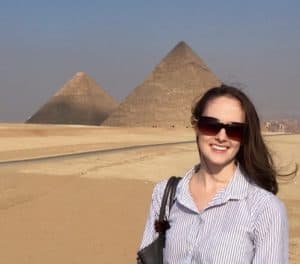 Cairo: Sakkara, the Pyramid complex, and the Sphinx.
Cairo: Sakkara, the Pyramid complex, and the Sphinx.
Egyptian History is extremely extensive – dating back to 3500 B.C., and therefore is pretty hard to explain it all in a couple of days. However, especially if you are using Cairo has a jumping off point for a cruise up the Nile (which I highly suggest, both in terms of scenery, and history), your first full day in Cairo should be devoted to the succession of pyramid building – which means you need to start at Sakkara. Once out of central Cairo (which is concentrated on the East side of the Nile), you have to cross the Nile over into the Giza portion of Greater Cairo on the West bank, and then drive south for about 30 minutes to reach the Sakkara complex. The step-pyramid at Sakkara is the world’s oldest all-stone structure – imagined and designed by the famous Imhotep, architect extraordinaire to the pharaoh Djoser in 2600 B.C.
Moving along the succession of pyramid-building, from the Sakkara complex you can see what is referred to as the Bent Pyramid and the Red Pyramid – the 2nd and 3rd pyramids built in Egypt. The Bent Pyramid serves as a testament to the evolution of building pyramids – as they realized about 50 meters up that the angle at which they were building (54 degrees) was too large to be able to complete in a reasonable or structurally-sound manner, and switched to a shallower angle (43 degrees) to finish it. The builders learned from their mistakes, it seemed, as the next pyramid, the Red Pyramid, was started and finished at a 43 degree incline.
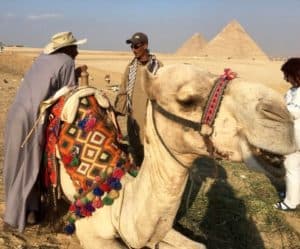 After walking around the Sakkara complex for a bit, including a quick descent into the tomb within one of the smaller, “newer” pyramids, we set off back in the direction of the Nile to take in the heavy-hitters: The Pyramids of Giza and the Sphinx. Our first stop after a quick lunch overlooking the Sphinx was the panoramic outlook of the 3 pyramids: The Great Pyramid of Khufu (2580 B.C.), the Pyramid of Khafre (2570 B.C.), and the smaller Pyramid of Menkaure (2510 B.C.). From the panoramic overlook, you can see the 3 pyramids together, and if Cairo’s morning haze has dissipated, the backdrop of the city itself: a very interesting mélange of ancient and modern.
After walking around the Sakkara complex for a bit, including a quick descent into the tomb within one of the smaller, “newer” pyramids, we set off back in the direction of the Nile to take in the heavy-hitters: The Pyramids of Giza and the Sphinx. Our first stop after a quick lunch overlooking the Sphinx was the panoramic outlook of the 3 pyramids: The Great Pyramid of Khufu (2580 B.C.), the Pyramid of Khafre (2570 B.C.), and the smaller Pyramid of Menkaure (2510 B.C.). From the panoramic overlook, you can see the 3 pyramids together, and if Cairo’s morning haze has dissipated, the backdrop of the city itself: a very interesting mélange of ancient and modern.
Our guides arranged for many of our group to go on a short camel ride – something I would suggest any takers to do THROUGH their guide – don’t try to haggle with the camel guys yourself. All the big tourist areas (Sakkara included) are full of men with camels and donkeys who will offer to take your photo with their animals – just know that they’re not doing this just to be nice and WILL EXPECT you to pay them afterward. The same goes with the camel riding – your guide will know what is a normal price to pay for a 10-ish minute camel ride and is in a much better situation of protecting your interests than you are (speaking the language is a huge plus…).
Once the other ladies had dismounted their dromedary steeds, (I opted to stay with my feet firmly on land, thank you very much), we drove over to Menkaure’s pyramid to go inside! Spoiler alert: there’s nothing to see once you’re inside (and you can’t take pictures anyway), but at least we got the bragging rights of saying we’d been INSIDE a pyramid, right?
By this time, we were running behind schedule (a combination of having to pull away group members from tchochke vendors, and what I like to refer to as “Egyptian time” – their polychronistic conception of time and the amount of time it actually takes to do things is pretty different than my Anglo-Saxon monochronism…), and had to rush over to the Sphinx before they stopped admitting visitors. Clearly a lot of other people had the same itinerary as we did, because the area overlooking the Sphinx was PACKED with tourists, mostly large groups. Not that I expected any different, but it’s still exacerbating trying to get photos without strangers in them…
Originally we were supposed to head back to the hotel after seeing Mr. Sphinx, but one of our group members thought that we should go see the Sound and Light Show at the pyramids after dark. So rather than drive back to the hotel only to turn around to make it back to the pyramids by 7 pm, we were taken to a couple stores where we could buy higher quality souvenirs and papyrus products.
Then we were off to the Sound and Light Show — which, in all our opinions, was not really worth the time. Yes, it was cool to see the pyramids and Sphinx lit up, but the narration was not particularly compelling and did not need to last 45 minutes. Honestly, I would have preferred to just overlook the lit-up pyramids and skip the long-winded historical explanation, especially after a full day of touring going off of not that much sleep.
We popped back on the bus and headed back to the Fairmont for our first of many delicious and comprehensive meals of the trip. I understand wanting to showcase all the amazing foods you offer – and appreciate it of course as I really like tasting a bit of everything. The sushi and seafood spread at the Southeast Asian-inspired Saigon was an interesting choice (as I would have expected us to do something more authentic of the destination we were in), but it was all very good, so I can’t complain!
Monday, October 16th
After a restful night’s sleep, we had breakfast with the Fairmont Nile City’s sales team at Napa Grill, the Fairmont’s all-day dining venue and then did our site inspection of the property.
As I mentioned earlier, the first 3 room categories (Fairmont Room, Deluxe Room, and Deluxe Nile Room) all have the same square footage just with different views. However, the layouts of the rooms, while similar, are not consistent across (and within) these categories; the most obvious differences being that some rooms have work desks while others do not, and the pretty drastic differences in decor that I mentioned before. We were then shown the highest room category, the Signature Room, which is almost double the size of the other room types, has a private balcony, and can accommodate a roll-away bed if needed.
We then went to peek at the Nile Suite and Deluxe Nile Suites. The Deluxe Nile Suites are bigger (100 sqm vs 75 sqm), and have a dining room and kitchenette, but both categories have separate living rooms with couches and working desks. I believe all the suite categories also had an extra half bathroom. The decor in the suites we saw were the lighter toned ones, but still had a clear yellow-gold and black theme, but reminded me of the Great Gatsby (Art Deco, I think).
This Fairmont, as I believe most Fairmonts do, also had a dedicated club lounge for Fairmont Gold room and suite guests. The Lounge was spacious – two stories with floor-to-ceiling windows looking out over the Nile. Fairmont Gold guests also enjoy 24-hour on-call butler service.
 Then we were off again with Mohammed and our Egyptologist guide Ibrahim to visit Coptic Cairo – part of the Old Town that serves as a reminder of Cairo’s (and Egypt’s) past as a stronghold of Christianity prior to the Muslim conquest. Today, about 10% of the Egyptian population identify as Coptic Orthodox or Catholic, but Egypt was once primarily a Christian city (after the Pharaonic period, and just prior to and during the Roman era). We first visited the Church of St. Sergius, which is believed by some to be where Mary, Joseph, and the baby Jesus stayed in Cairo during the period in which they were fleeing King Herod. I remember visiting this church back in 2008, and at that time was not all that impressed: it was dark, dusty, and dingy. I expected the same thing this time, but was pleasantly surprised that it had been recently restored and is now a much nicer place to visit. Afterward, we walked over to the Hanging Church, the most famous Coptic Christian church in Cairo, and also the seat of the Coptic Christian Pope. The Hanging Church is built on top of an ancient Roman Babylon Fortress, which gives it its raised location and name.
Then we were off again with Mohammed and our Egyptologist guide Ibrahim to visit Coptic Cairo – part of the Old Town that serves as a reminder of Cairo’s (and Egypt’s) past as a stronghold of Christianity prior to the Muslim conquest. Today, about 10% of the Egyptian population identify as Coptic Orthodox or Catholic, but Egypt was once primarily a Christian city (after the Pharaonic period, and just prior to and during the Roman era). We first visited the Church of St. Sergius, which is believed by some to be where Mary, Joseph, and the baby Jesus stayed in Cairo during the period in which they were fleeing King Herod. I remember visiting this church back in 2008, and at that time was not all that impressed: it was dark, dusty, and dingy. I expected the same thing this time, but was pleasantly surprised that it had been recently restored and is now a much nicer place to visit. Afterward, we walked over to the Hanging Church, the most famous Coptic Christian church in Cairo, and also the seat of the Coptic Christian Pope. The Hanging Church is built on top of an ancient Roman Babylon Fortress, which gives it its raised location and name.
Beginning with Christian Cairo, normally I would suggest then spending the afternoon visiting some of Cairo’s mosques – Sultan Hassan and/or the Muhammad Ali within the Citadel, or even Al-Alzhar (in my opinion, one of the most stunning and peaceful mosques) if you have time. However, as we only had 2 full days, our itinerary cut out the mosques and substituted the Egyptian Museum for our afternoon activity. Personally, I think visiting a mosque in a Muslim country is a must – and not just because I love the architecture. When such a big part of a country’s culture is derived from Islam, I think NOT visiting at least one mosque gives the impression that you’re not open to learning about your host country’s way of life. I am not a religious person, but I have spent some of the most peaceful moments in my life within the walls of mosques – and I personally want other people and travelers to at least get a glimpse of the REAL Islam (not the highly radicalized Islam that is unfortunately plastered all over the news). Islamic, Christian, and Jewish values and morals are virtually the same when it all comes down to it. Yes, there are differences, obviously, otherwise they wouldn’t be considered separate religions, but at the core it’s all about being kind, caring for one another, and simply trying to be the best person you can be, all while attempting to find some inner peace. AND now I will get off my soapbox…
The Egyptian Museum houses an extensive collection of Egyptian artifacts, mostly from the Pharaonic period if I remember correctly. The museum itself sits right off of Tahrir Square (of the Arab 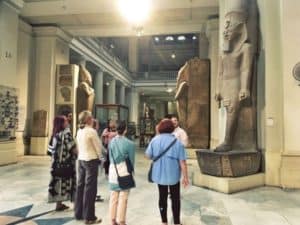 Spring protest fame) and right across the street from the Nile Ritz Carlton Cairo. It’s not a particularly large building, which is one of the reasons why they are currently building a new, larger facility by the Pyramid complex. The new museum is slated to open in mid-2018, but until then, the mummy room, King Tut’s Tomb and jewelry room, and other pieces brought over from the Valley of the Kings will be on display in central Cairo. To be quite honest, I think the new museum will be a good improvement – the current space can only hold about half of the total artifacts, and although the building is historical, it could use modern technology such as better lighting and preservation techniques than the current set-up.
Spring protest fame) and right across the street from the Nile Ritz Carlton Cairo. It’s not a particularly large building, which is one of the reasons why they are currently building a new, larger facility by the Pyramid complex. The new museum is slated to open in mid-2018, but until then, the mummy room, King Tut’s Tomb and jewelry room, and other pieces brought over from the Valley of the Kings will be on display in central Cairo. To be quite honest, I think the new museum will be a good improvement – the current space can only hold about half of the total artifacts, and although the building is historical, it could use modern technology such as better lighting and preservation techniques than the current set-up.
After hanging out with the mummies and saying goodbye to our dear guide Ibrahim, we headed over to the Sofitel El Gezirah – located just across (half of) the Nile on the tip of the affluent Zamalek district, and very close to the high-end Cairo shopping. An entrance into the lobby will not be forgotten: high ornate wood ceilings with an amazing chandelier suspended over giant windows looking out onto the Nile – especially stunning when the sun is beginning to set.
Each one of the over 400 rooms has at least a partial view of the Nile, and I vastly preferred the decor and general luxurious ambience to the Fairmont. It felt newer and much less in need of a make-over. The location is very central – convenient for getting to sites on both sides of the river. Rooms run around 32 sqm and there are only two room categories: Superior & Luxury. Superiors have partial Nile views, while Luxury ones have full Nile views, but the room layout, is the same. All rooms and suites have balconies (which you have to sign a waiver at check-in to use). The difference between the Junior Suite and Prestige Suite is again a matter of partial versus full Nile view – which makes the Junior Suite not really a Junior Suite at all (there’s a sliding door separating the bedroom from the living room).
The Sofitel El Gezirah has 6 different dining venues, ranging from the casual Italian Mi Casa, to an Indian restaurant that transforms into a trendy late-night 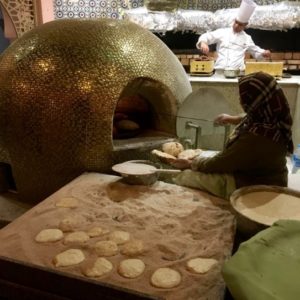 spot, to a Moroccan restaurant with terrace, to the fine-dining French fusion of Le Deck – which floats on top of the Nile. While all of these looked beautiful and sounded delicious, we had dinner at Kebabgy – where the cuisine was authentic Egyptian barbecue. We had an amazing spread of various mezze (hummus, tabouleh, etc), and piles of grilled chicken, lamb, kofta, as well as freshly baked Egyptian whole-wheat flatbread (aish baladi) out on the terrace overlooking the Nile. It was a wonderful night to cap off our Cairo experience!
spot, to a Moroccan restaurant with terrace, to the fine-dining French fusion of Le Deck – which floats on top of the Nile. While all of these looked beautiful and sounded delicious, we had dinner at Kebabgy – where the cuisine was authentic Egyptian barbecue. We had an amazing spread of various mezze (hummus, tabouleh, etc), and piles of grilled chicken, lamb, kofta, as well as freshly baked Egyptian whole-wheat flatbread (aish baladi) out on the terrace overlooking the Nile. It was a wonderful night to cap off our Cairo experience!
Tuesday, October 17th
We had an early wake-up call on this morning, as we were on an 8:45 am flight back to Istanbul, but the Fairmont graciously packed us breakfast boxes to take on the bus as we left at 5:30 am (actually it was more like 6, since someone didn’t print their Turkish visa).
At the Cairo airport, it’s worth noting that all bags have to go through scanners prior to even getting to the check-in counters — so if you’ve got a lot of luggage, just know that you are expected to load it them on the conveyor belts yourself. Check-in took slightly longer than expected, as it would seem that no one else had ever queued before. After check-in you have to fill out a departure immigration form, wait in another line for passport control. Once through that line, you enter the terminal but before boarding the aircraft you have to go through another security screening. Basically, it’s important to get to your gate well before flight time as there is that extra layer of security prior to actually getting to the jet-bridge.
The flight itself was uneventful (the best kind of flight!). I dozed off a couple minutes after take-off so I can’t comment on the meal that was served, but after my breakfast box I didn’t really need another meal. We landed in Istanbul to blue, sunny skies, made our way off the plane and finagled our way through the Priority Lane (it helps having a Turkish Airways rep with you! 😊). One thing I don’t remember is seeing signs of where to get a sticker visa-on-arrival, but that was probably because I wasn’t looking for it. Luckily, we had all gotten e-visas prior to the diplomatic squabble between the US and Turkey days before our departure, and all breezed through.
Originally, our itinerary had a free afternoon after we got to Istanbul, but by the time we got there we had added a lunch and some light touring instead. I know everyone had kind of been looking forward to the free time to maybe hit the spa, but I’m glad we ended up filling our day. Yes, we were all exhausted, but 2 full days in Istanbul really does not do the city justice and getting in one of the main sites (Dolmabace Palace) was nice – unfortunately I don’t know when I’ll get back there!!
We drove in from the airport, didn’t really hit any traffic and got to our lunch spot near the pier, Karakoy Lokantasi, in about 40 minutes. One note about the pier: it’s basically shut down at this point for renovation (which I’m told it really needed); and due to fully open in 2020, although I think it will partially open for ports of call before then. I never got a straight answer as to whether the decision to completely close the port came before or after cruise lines began pulling Istanbul off their itineraries. I’ve had cruise line reps tell me that they pulled Istanbul because passengers didn’t want to go to Istanbul; but the locals say they took Istanbul out of itineraries because the port was closing. Personally, I think it’s a bit of both…but we’ve got a bit of a chicken and egg situation here – there are always two sides to each story, no?
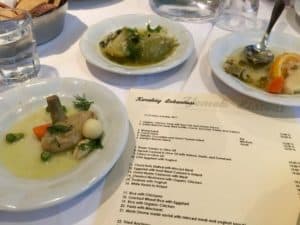 We met the owner of our tour operator, Karen, at lunch, and of course our number one question for her was: so how much has American reticence (aka fear) to come to Turkey affected the tourism business? We were pleasantly surprised when we found out that although tourists from the US are down, European and Middle Eastern tourists are still coming to Turkey in droves, and actually, tourism from the South American countries has increased. Without getting back up on my soapbox, all I’ll say is that this makes perfect sense to me; and although I think it’s a shame US tourists are discounting Turkey as a destination, I’m glad that tourism isn’t suffering as much as I was led to believe.
We met the owner of our tour operator, Karen, at lunch, and of course our number one question for her was: so how much has American reticence (aka fear) to come to Turkey affected the tourism business? We were pleasantly surprised when we found out that although tourists from the US are down, European and Middle Eastern tourists are still coming to Turkey in droves, and actually, tourism from the South American countries has increased. Without getting back up on my soapbox, all I’ll say is that this makes perfect sense to me; and although I think it’s a shame US tourists are discounting Turkey as a destination, I’m glad that tourism isn’t suffering as much as I was led to believe.
Anyway, after some delicious Turkish mezzes and dishes, I announced to the table that I really wanted to get baklava. And wouldn’t you know, the most well-known place to get baklava, Karakoy Gulluoglu, was about 5 doors down the street! Cue: impromptu field trip to grab some baklava and Turkish coffee before our jaunt off to Dolmabahce Palace. Personally, I can’t think of a better introduction to Turkey… 😊
Our visit to Dolmabahce was short and sweet (everyone was really dragging at this point), but I’m really glad I got to see it, especially because it ties into the history that we learned the following 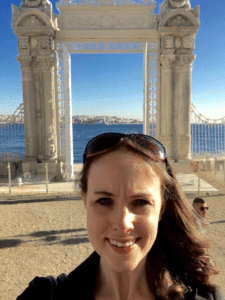 days. Basically we saw them in the “wrong” order, but Dolmabahce Palace was built by one of the 19th century sultans who was tired of the old Topkapi palace and wanted something more in the style of European palaces. So, the interior of the palace is very reminiscent of Italian and French palaces I’ve visited in the past, albeit a mish-mash of styles between the different rooms. It was the home of the Ottoman Sultans until the creation of the Turkish Republic, and then ownership was transferred to the government. While they still use the palace for government functions and receptions, it is mainly a museum. You cannot, however, enter the palace without being a part of a guided tour – either with a private guide or with one of the museum employee guides.
days. Basically we saw them in the “wrong” order, but Dolmabahce Palace was built by one of the 19th century sultans who was tired of the old Topkapi palace and wanted something more in the style of European palaces. So, the interior of the palace is very reminiscent of Italian and French palaces I’ve visited in the past, albeit a mish-mash of styles between the different rooms. It was the home of the Ottoman Sultans until the creation of the Turkish Republic, and then ownership was transferred to the government. While they still use the palace for government functions and receptions, it is mainly a museum. You cannot, however, enter the palace without being a part of a guided tour – either with a private guide or with one of the museum employee guides.
I enjoyed the introduction to Turkish palaces, which differ from the European ones I’ve visited in their layout as they kept a separate section for the wives and children (the harem). My favorite part, however, is its outdoor space. It is built along the Bosphorus, and there are spectacular views across and along the river through these beautiful white iron gates…very picturesque. Thank goodness we had amazing weather, otherwise I don’t know if it would have been as pretty!
We then drove to the Fairmont Quasar Istanbul, where we stayed for our first night in Istanbul. The property is the first Fairmont in Turkey and just opened in early 2017. It is situated in one of the newer business districts, Mecidiyeköy, and on the Northeastern outskirts of the central downtown area. While not on the Bosphorus like many of the other luxury hotels in Istanbul, it does have the advantage of being shiny and new: with a very sleek and modern design.
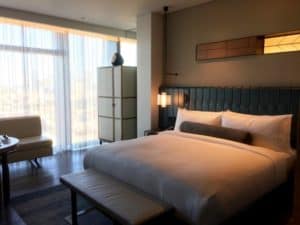 Our rooms were spacious – 40 sqm – and had floor to ceiling windows with views of the city skyline – which gave the room an even larger feel. One drawback to newer hotels, however, is all the new automation in the rooms — it took me quite a while to figure out what buttons operated which things. I believe the iPads are supposed to be able to control everything, but the hotel hadn’t yet made them operational, so I was left to try to decipher a bunch of pictures instead. Not a huge deal, but something as simple as opening the curtains shouldn’t take 10 minutes! The bathrooms had double sinks, and come with either a tub or a Turkish hammam-style bath (a set of large basins). I’m not someone who takes
Our rooms were spacious – 40 sqm – and had floor to ceiling windows with views of the city skyline – which gave the room an even larger feel. One drawback to newer hotels, however, is all the new automation in the rooms — it took me quite a while to figure out what buttons operated which things. I believe the iPads are supposed to be able to control everything, but the hotel hadn’t yet made them operational, so I was left to try to decipher a bunch of pictures instead. Not a huge deal, but something as simple as opening the curtains shouldn’t take 10 minutes! The bathrooms had double sinks, and come with either a tub or a Turkish hammam-style bath (a set of large basins). I’m not someone who takes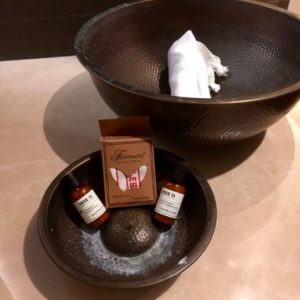 baths, so the Turkish style was fine for me, but if someone has a strong preference one way or another the only way to communicate that to the property is by a request. Another nice attention to details was that the bathroom amenities came personalized with our names on them!
baths, so the Turkish style was fine for me, but if someone has a strong preference one way or another the only way to communicate that to the property is by a request. Another nice attention to details was that the bathroom amenities came personalized with our names on them!
We had dinner at the newly-opened Aila Restaurant on property – a Turkish restaurant focusing on regional mezzes and ocakbaşı, or Turkish charcoal barbecue. Here I was introduced to muhammara – a roasted red pepper and walnut paste that quickly surpassed hummus as my favorite mezze spreadable. We also had a litany of other dishes, including octopus, a whole bunch of lamb prepared different ways, grilled liver (which, despite its reputation, I didn’t find that bad), and many eggplant based dishes – which seem to be very popular in Turkey. Basically we were over-fed once again!
Wednesday October 18th
As we were only spending one night at the Fairmont, we were a little more pressed for time in the morning making sure everything was packed and room accounts paid for and such, so it was nice to just walk to the other side of the floor to have breakfast in the Fairmont Gold Lounge. The spread was not as extensive as some club lounge breakfasts I’ve seen before, but by this time in the trip I had eaten so much that all I really needed was some coffee, smoked salmon, and a hard-boiled egg – all of which were speedily available.
Downstairs we went with all our luggage to meet our tour guide Cenk (pronounced Jenk), who would be accompanying us for the next 2 days as we took in as much of the city as possible. Driving over to the “Peninsula” or Old Town took about thirty minutes with some mild traffic, and then we were in the heart of the pedestrian-focused area around the Blue Mosque and Hagia Sofia.
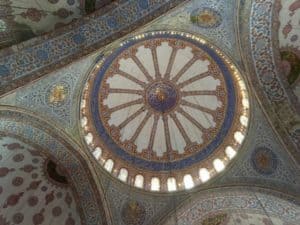 Our first stop was the Sultan Ahmet Mosque, or Blue Mosque as it’s more commonly known – a place I had wanted to visit for years. The name Blue Mosque comes from the hand painted blue tiles within the mosque itself – not its outward appearance (honestly it doesn’t appear all that blue on the inside either). The interior is stunning, but I would have liked to be able to walk into the portion directly underneath the main dome to really take in the architecture. Tourists are cordoned off at the back, presumably as to not disturb those visitors who are using the mosque for its intended purpose of prayer. I’ve been in mosques where during non-service times you can actually walk all around the mosque – but I suppose this way is the politer way of going about things.
Our first stop was the Sultan Ahmet Mosque, or Blue Mosque as it’s more commonly known – a place I had wanted to visit for years. The name Blue Mosque comes from the hand painted blue tiles within the mosque itself – not its outward appearance (honestly it doesn’t appear all that blue on the inside either). The interior is stunning, but I would have liked to be able to walk into the portion directly underneath the main dome to really take in the architecture. Tourists are cordoned off at the back, presumably as to not disturb those visitors who are using the mosque for its intended purpose of prayer. I’ve been in mosques where during non-service times you can actually walk all around the mosque – but I suppose this way is the politer way of going about things.
Next, we walked over to the Hagia Sofia – a short but pleasant walk through a public garden with a fountain, which as it was a bright and sunny day in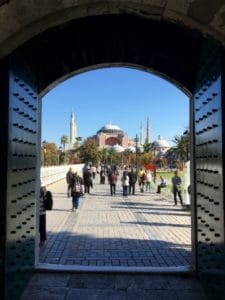 Istanbul was a great time to take exterior photos of both the Blue Mosque and Hagia Sofia. This site’s big draw is its very interesting history: the current building was constructed as a Greek Orthodox cathedral in the 11th century when Constantinople was part of the greater Roman empire (by then it was considered East Rome or Byzantium). It remained a cathedral for 400 years or so until Constantinople was conquered by the Ottoman Empire and Islam became the official religion. Wanting to repurpose the building as a mosque, the Ottomans decided against razing the building, but had to do something about the interior. Throughout the years, the interior of Hagia Sophia had acquired incredibly intricate mosaics depicting Jesus, Mary, and other biblical figures. However, Islamic customs do not allow for images of people within mosques, so the Ottomans decided to just plaster over the mosaics. While this may seem insensitive, it’s a very good thing they did, as the thick layer of plaster preserved the mosaics really well – so that when Hagia Sophia was turned into a museum instead of a place of worship in the 1930s, restoration teams could work to display them! It now has both the Christian mosaics that have been uncovered, and the Islamic adornments – AND an unofficial mascot: Gli, the Hagia Sophia cat, whose accolades include being pet by then-President Obama (https://www.tripadvisor.com/LocationPhotoDirectLink-g293974-d294497-i21441094-Hagia_Sophia_Museum_Church_Ayasofya-Istanbul.html)!
Istanbul was a great time to take exterior photos of both the Blue Mosque and Hagia Sofia. This site’s big draw is its very interesting history: the current building was constructed as a Greek Orthodox cathedral in the 11th century when Constantinople was part of the greater Roman empire (by then it was considered East Rome or Byzantium). It remained a cathedral for 400 years or so until Constantinople was conquered by the Ottoman Empire and Islam became the official religion. Wanting to repurpose the building as a mosque, the Ottomans decided against razing the building, but had to do something about the interior. Throughout the years, the interior of Hagia Sophia had acquired incredibly intricate mosaics depicting Jesus, Mary, and other biblical figures. However, Islamic customs do not allow for images of people within mosques, so the Ottomans decided to just plaster over the mosaics. While this may seem insensitive, it’s a very good thing they did, as the thick layer of plaster preserved the mosaics really well – so that when Hagia Sophia was turned into a museum instead of a place of worship in the 1930s, restoration teams could work to display them! It now has both the Christian mosaics that have been uncovered, and the Islamic adornments – AND an unofficial mascot: Gli, the Hagia Sophia cat, whose accolades include being pet by then-President Obama (https://www.tripadvisor.com/LocationPhotoDirectLink-g293974-d294497-i21441094-Hagia_Sophia_Museum_Church_Ayasofya-Istanbul.html)!
After walking around Hagia Sophia for a while (including several minutes taking pictures of Gli), we had worked up an appetite; so we headed over in the direction of Topkapi Palace – also within walking distance. Topkapi Palace is quite extensive, with 4 separate courtyards, so we kind of sped our way through them to get to Konyali Lokanti, one of the restaurants located within the palace grounds. There we had a nice lunch al fresco (Istanbul was unusually warm for mid-October – in the mid-70s!) with a couple of other members of the Sea Song team. The setting of the restaurant is very convenient – being within the palace grounds – and the terrace overlooking the Bosphorus was a lovely place where we were introduced to yet another delicious Turkish culinary delight: borek – basically filled savory hand pies.
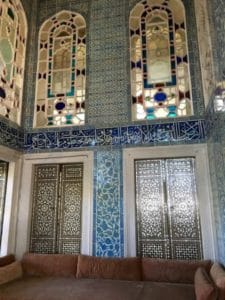 Seeing as we just power walked through Topkapi to get to lunch, it was then time to actually tour the palace grounds. Topkapi was where the sultans lived prior to the one who built Dolmabahce, and you can tell that the buildings aren’t all from the same era as each sultan built whatever he wanted in whatever style he wished. We began in the fourth courtyard, the furthest one from the entrance – and as such served as a private space for the Imperial family for retreats, coming of age ceremonies like circumcision, and receptions. We then walked through the third courtyard, whose main tourist attraction is the Imperial Treasury, which showcases jewelry, artwork, and other displays of the massive wealth of the Ottoman Empire. Unfortunately, the Imperial Treasury was closed for renovation when we were there, so we continued on through the Gate of Felicity into the Second Courtyard – which was primarily used as the administrative and political
Seeing as we just power walked through Topkapi to get to lunch, it was then time to actually tour the palace grounds. Topkapi was where the sultans lived prior to the one who built Dolmabahce, and you can tell that the buildings aren’t all from the same era as each sultan built whatever he wanted in whatever style he wished. We began in the fourth courtyard, the furthest one from the entrance – and as such served as a private space for the Imperial family for retreats, coming of age ceremonies like circumcision, and receptions. We then walked through the third courtyard, whose main tourist attraction is the Imperial Treasury, which showcases jewelry, artwork, and other displays of the massive wealth of the Ottoman Empire. Unfortunately, the Imperial Treasury was closed for renovation when we were there, so we continued on through the Gate of Felicity into the Second Courtyard – which was primarily used as the administrative and political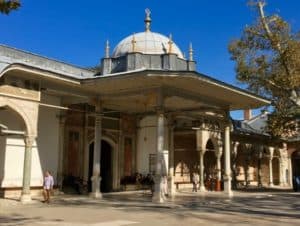 center. This was where the ministers and members of the court met to discuss matters of state. We then made our way into the harem – which encompasses four hundred apartments where the sultan, the Queen Mother, the sultan’s wives and children, and his “favorites” (aka concubines) lived. Activities within the harem were controlled by the Queen Mother – who went so far as to decide which wife or “favorite” would be sent to the sultan’s apartments each night! Much of the harem area is under renovation at the moment, but still worth the extra ticket to visit as long as you’ve got a guide to tell you all the interesting stories! Thus concluded our speed-tour of Topkapi; a visitor who wants to learn more in depth information about the history of this sprawling palace could easily spend a half-day here, maybe more depending on how many of the sections were open to the public at the time.
center. This was where the ministers and members of the court met to discuss matters of state. We then made our way into the harem – which encompasses four hundred apartments where the sultan, the Queen Mother, the sultan’s wives and children, and his “favorites” (aka concubines) lived. Activities within the harem were controlled by the Queen Mother – who went so far as to decide which wife or “favorite” would be sent to the sultan’s apartments each night! Much of the harem area is under renovation at the moment, but still worth the extra ticket to visit as long as you’ve got a guide to tell you all the interesting stories! Thus concluded our speed-tour of Topkapi; a visitor who wants to learn more in depth information about the history of this sprawling palace could easily spend a half-day here, maybe more depending on how many of the sections were open to the public at the time.
By this time in the day, we were getting dangerously close to rush hour in Istanbul (which we would find out is pretty bad), so we scampered over to the Basilica Cistern, the largest cistern in Istanbul, which was used to store water. Usually it is still filled with water, but unfortunately again for us, half of the structure was under renovation, so they had to drain out all the water. I’m told it’s very pretty down there lit up with it full, but I will have to see for myself on my next trip to Istanbul! Once it’s fully open to the public again, they will also begin having small (usually classical) concerts in the Cistern again – which is something I think would be amazing to go to.
Emerging from the cistern, we piled in the bus in order to drive to our home base for the next two nights: The Raffles Istanbul. After an extremely warm welcome in which it seemed every member of staff were waiting to greet us, we were each taken by our personal butler up to our rooms (every room at the Raffles Istanbul includes 24-hour butler service). At an average of 700 sq feet, even our entry-level Deluxe Rooms were had both a spacious bedroom/living area and bathroom. Almost all the rooms also have a walk-in closet, which was very much appreciated after moving hotels so much during the week – I could finally unpack my suitcase! Our welcome amenities were exceptional as well: a baklava display, large bowls of pistachios, walnuts, dried dates, and figs – they really pulled out all the snacking stops! I had just enough time to snap some pictures of the sun setting over the city from my balcony and then we all met in the lobby for our site inspection.
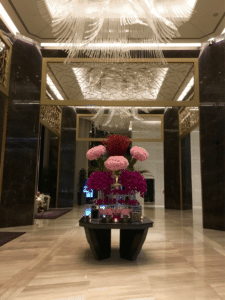 The Raffles Istanbul is beautiful. While it lacks the location on the Bosphorus of other luxury hotels, it more than makes up for it with a luxurious feel and much larger than average room sizes. The hotel itself is attached to the Zorlu Center, which is a combination of an upscale shopping mall and a performing arts center that caters to the Levant neighborhood’s affluent visitors and residents. Rooms start at 650 sq feet (compared with the Four Seasons Sultanahmet & Bosphorus at 450 sq feet, and Ciragan Palace’s 350 sq feet), and as I mentioned before, all have butler service, walk-in closets, and balconies. So, if space is what you want, Raffles is your best bet! Rooms are split between Deluxe, Premier, and Signature – each larger than the previous and with better views. The hotel also has a good suite inventory – 49 of them, mostly one-bedroom, all the way up to the Raffles Suite in which Lady Gaga was their first guest! For those who may be staying longer or just want the convenience of a full kitchen, Raffles also has 1 and 2 bedroom residences. The spa and indoor swimming pool area are also very striking.
The Raffles Istanbul is beautiful. While it lacks the location on the Bosphorus of other luxury hotels, it more than makes up for it with a luxurious feel and much larger than average room sizes. The hotel itself is attached to the Zorlu Center, which is a combination of an upscale shopping mall and a performing arts center that caters to the Levant neighborhood’s affluent visitors and residents. Rooms start at 650 sq feet (compared with the Four Seasons Sultanahmet & Bosphorus at 450 sq feet, and Ciragan Palace’s 350 sq feet), and as I mentioned before, all have butler service, walk-in closets, and balconies. So, if space is what you want, Raffles is your best bet! Rooms are split between Deluxe, Premier, and Signature – each larger than the previous and with better views. The hotel also has a good suite inventory – 49 of them, mostly one-bedroom, all the way up to the Raffles Suite in which Lady Gaga was their first guest! For those who may be staying longer or just want the convenience of a full kitchen, Raffles also has 1 and 2 bedroom residences. The spa and indoor swimming pool area are also very striking.
Following the quick inspection (we only saw one room, one residence, and one suite – the Raffles (aka Lady Gaga) suite, we sat down for another long and filling 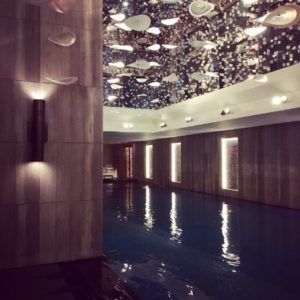 dinner at Rocca, the property’s all day dining restaurant. We had a set menu, and none of the starters or entrees were Turkish per se (although I believe there were more Turkish options on the main menu), but we had had so much kofte, kebab, and other traditional Turkish cuisine in the previous 24 hours that it was a nice little reprieve – but also very delicious.
dinner at Rocca, the property’s all day dining restaurant. We had a set menu, and none of the starters or entrees were Turkish per se (although I believe there were more Turkish options on the main menu), but we had had so much kofte, kebab, and other traditional Turkish cuisine in the previous 24 hours that it was a nice little reprieve – but also very delicious.
Thursday October 19th
 Our last full day in Istanbul! Instead of going down to the breakfast buffet (also at Rocca), I opted instead for my leftover welcome amenity goodies (who says baklava isn’t a breakfast food?), and then met everyone downstairs to board our bus that would take us to our morning cruise on the Bosphorus. To say we had perfect weather would be an understatement – beautiful blue skies and sunshine for the 3rd day in a row. It got a bit chilly once we were out on the water, but our yacht attendant brought us all shawls and hot tea and coffee to temper the breeze coming off the water.
Our last full day in Istanbul! Instead of going down to the breakfast buffet (also at Rocca), I opted instead for my leftover welcome amenity goodies (who says baklava isn’t a breakfast food?), and then met everyone downstairs to board our bus that would take us to our morning cruise on the Bosphorus. To say we had perfect weather would be an understatement – beautiful blue skies and sunshine for the 3rd day in a row. It got a bit chilly once we were out on the water, but our yacht attendant brought us all shawls and hot tea and coffee to temper the breeze coming off the water.
If at all possible, (and as long as weather conditions are favorable), I highly recommend seeing Istanbul from the Bosphorus – so much of Istanbul’s history and current culture is tied to the Bosphorus that being in the midst of it really is breathtaking. Most yacht charters such as ours don’t last more than an hour and half and it’s a nice little cruise up the European side and back the Asian side. If nothing else, it’s a good way to orientate yourself with the location of the main city sights.
Once again, we were behind schedule, so we switched up our itinerary and headed to the Spice Bazaar so that we could properly spend all our Turkish lira… After the Grand Bazaar, the Spice Bazaar is Istanbul’s largest indoor shopping market and while spices are its namesake, the stalls sell other foodstuffs like turkish delight, dried fruits, nuts, every kind of tea you can imagine, as well as cheapo souvenirs (better left for the Grand Bazaar). All of us crammed into one of the first stalls as we only had (or were supposed to have) 30 minutes for shopping. The number of samples the vendors give away puts Costco to shame – I think I may have ate my weight in honey glazed, sesame coated peanuts. For the most part I managed to limit my shopping to some dried fruit for the office, although I had my eye on some teas (that I decided against because they were all loose-leaf and I don’t own a tea strainer). Everyone else did not have nearly as much self restraint – but part of that may have been because if you don’t watch the vendors closely and specify how much of each product you want they’ll just keep loading it in a bag (and everything is sold by weight). The colors of the spices were very enticing, but not really knowing how to cook or even what spices I might need to cook, I managed to stay away from them too.
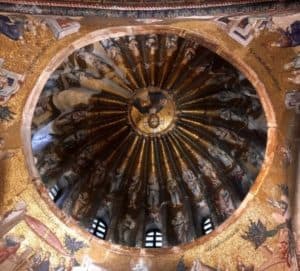 Once we finally dragged everyone out of the Spice Bazaar, off we headed to our only cultural tour of the day: the Chora Church. Again, we did a pretty quick speed-tour where Cenk described to us the Bible stories in the mosaics and frescoes that adorn the ceilings and walls – (most of which I was familiar with, yay Sunday School). These mosaics are some of the most well-preserved and stunning in Istanbul. Cenk gave us about 10 minutes to walk around by ourselves after he explained the crucial mosaics, but I had spotted some stray cats in the square outside the Church, and being more interested in them than Bible stories, wandered around some of the side streets snapping photos of the adorable furballs. Fun fact: as I learned by watching the documentary Kedi, Istanbul has a long history of caring for and living with stray (not feral) cats who families and businesses “adopt”. I didn’t see as many of these felines as I had wanted to, but a lot of that was probably because we did so much driving around instead of wandering through the city.
Once we finally dragged everyone out of the Spice Bazaar, off we headed to our only cultural tour of the day: the Chora Church. Again, we did a pretty quick speed-tour where Cenk described to us the Bible stories in the mosaics and frescoes that adorn the ceilings and walls – (most of which I was familiar with, yay Sunday School). These mosaics are some of the most well-preserved and stunning in Istanbul. Cenk gave us about 10 minutes to walk around by ourselves after he explained the crucial mosaics, but I had spotted some stray cats in the square outside the Church, and being more interested in them than Bible stories, wandered around some of the side streets snapping photos of the adorable furballs. Fun fact: as I learned by watching the documentary Kedi, Istanbul has a long history of caring for and living with stray (not feral) cats who families and businesses “adopt”. I didn’t see as many of these felines as I had wanted to, but a lot of that was probably because we did so much driving around instead of wandering through the city.
As if we weren’t full enough from our Spice Bazaar sampling, we headed off to lunch at Nar Lokanta Restaurant, a stone’s throw away from the Grand Bazaar. We ate al fresco on one of the rooftops, and again enjoyed Turkish and Levantine dishes that we could serve ourselves from the buffet. I know buffets aren’t seen as the classiest way to have a meal, but I’m an advocate of them, especially on these FAM trips where you are normally just overfed…this way everyone could have as much (or in most of our cases, as little) as we wanted without feeling impolite that I was leaving food on the table. I went heavy on the mezzes, skipped the main dishes, and instead treated myself to more than one dessert.
After a quick pop in a rug store, we were let off our leashes to enter the Grand Bazaar and shop for everything from jewelry to Turkish cotton towels to scarves to knock-off leather goods to literally anything else you could possibly want. The place is massive, and quite overwhelming – you could easily spend an entire day there and not visit each vendor. Being the time-efficient person I am, I made my purchases rather quickly, and began wandering a bit before realizing how warm and un-ventilated it was (also there were quite a fair number of people smoking inside, which I’m not sure is actually allowed, but they were doing it anyway). I had taken a fair number of turns and gotten pretty discombobulated, so I searched for the vendor that looked the least likely to hit on me and asked how to get to Gate 1. Back out into the fresh air I went, 30 minutes ahead of our scheduled meeting time, so I stopped in a cafe and got some salep, a milky chai-like beverage made from the flour of crushed orchids.
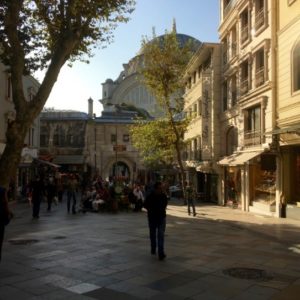 I sat on a bench in the sunshine waiting for the others to return, casually sipping my salep, and I felt perfectly safe. Honestly, I felt like I was back in my days of traveling around Europe by myself – just with a different language on passersby’s lips.
I sat on a bench in the sunshine waiting for the others to return, casually sipping my salep, and I felt perfectly safe. Honestly, I felt like I was back in my days of traveling around Europe by myself – just with a different language on passersby’s lips.
Everyone (shockingly) made it to the rendez-vous point on time, and although by this time it was 4:45 pm, our plan was to drive back to the Raffles, change, and then drive to the Swissotel for our site inspection and dinner. However, here is when we got a taste of real Istanbul downtown traffic — we crawled along the main roads for ages with everyone else trying to get home (most locals work in the European part, but live in the Asian part, so there’s quite a bit of traffic trying to get over the bridges and through the under-Bosphorus chunnel). After being stuck at one light for nearly 15 minutes, it became clear that we were not going to make it all the way north to Levant and then back down to Besiktas in time, it was decided that we should just go directly to the Swissotel and not risk being an hour late.
The Swissotel The Bosphorus is much larger than the other two hotels we stayed at in Istanbul (over 500 rooms compared to the Fairmont’s 209 and 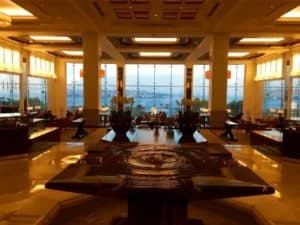 the Raffles’s 181), and as such is popular with groups and conventions. The larger size means, however, that there are a few more on-property dining venues. I found the room product to be good, but not as luxurious as the other two. Average room sizes are smaller too, but still relatively spacious (entry-level starts around 400 sq ft). Location-wise, however, this property has an advantage over the other two as it is in the city center and overlooks the Bosphorus, which means the rooms (other than the Garden View) have more desirable views. The most popular room category is their Corner Bosphorus Room, as they provide more space and the two walls of windows overlooking the river, but do keep in mind that these only come in King-bedded options.
the Raffles’s 181), and as such is popular with groups and conventions. The larger size means, however, that there are a few more on-property dining venues. I found the room product to be good, but not as luxurious as the other two. Average room sizes are smaller too, but still relatively spacious (entry-level starts around 400 sq ft). Location-wise, however, this property has an advantage over the other two as it is in the city center and overlooks the Bosphorus, which means the rooms (other than the Garden View) have more desirable views. The most popular room category is their Corner Bosphorus Room, as they provide more space and the two walls of windows overlooking the river, but do keep in mind that these only come in King-bedded options.
I would definitely recommend booking one of the Executive Rooms or Suites as they are generally in a different building than the large groups, and also provide access to the spacious Executive Lounge, which means you can enjoy breakfast overlooking the Bosphorus (this is not a Virtuoso property so clients wouldn’t get a breakfast credit), as well as snack presentations, and an honor bar throughout the day. The property has also recently rolled out 7 Loft Suites – which are very cool and contemporary. Although not suitable for those clients with difficulty with stairs, they do provide a unique two-story suite experience.
We had a lovely last dinner with the Swissotel sales team and our Sea Song contacts before saying our good-byes and hopping in the bus back to the Raffles for one more sleep!
Friday October 20th
Our pick-up wasn’t until 10:30 am this morning, so made good use of the morning to go down to breakfast and visit the steam room in the spa. By this point in the trip everyone was either feeling a cold coming on or already had acquired one – and I knew that the little cough and sinus congestion I had would only become unbearable on an airplane. It was only my second time using a steam room (the first being in Koh Samui), but as I have a rather feeble upper respiratory constitution, I think I could definitely get used to having access to one a couple times a week. I had a relaxing 40 minutes or so hopping in and out, and then resigned myself to get my butt back up to my room to pack.
Our Istanbul to Chicago flight didn’t depart until 2 pm, but as we were flying business class, the goal was to get to the airport early enough so we could have ample time to spend in the Turkish Airlines lounge. I believe we arrived at the airport after about a 40 minute drive, and then it was time to face security and check-in procedures!
Istanbul Ataturk Airport is another of those that requires passengers to put ALL bags through scanners prior to going to the check-in desks, so that’s one extra line you have to wait in and account for in your calculation of when to arrive at the airport. Next, as US citizens (I believe Canadian, Israeli, and, UK citizens have this requirement too), we had to go through a separate passport check prior to getting to the counter. We were then allowed to approach the check-in desks to drop our baggage and receive our boarding passes. Next: the normal bag screen of your carry-on luggage that all airports have. We had the bonus of going through the separate Business/First Class line that led directly into the lounge, however, this also tacked on about 15 minutes (the regular line for Economy passengers looked incredibly busy, so I would imagine it would have taken at least 40 minutes to get through that line).
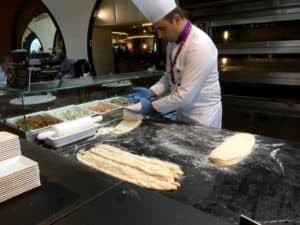 Once all that was finished, we only had about 45 minutes prior to our scheduled boarding time (more on why you should go to the gate at that time later) to check out the lounge. Again, I am not a seasoned Business/First class passenger so my perception of lounges may be skewed…but this lounge is beyond nice! There are food stations all over the place, from a chef making pide (the Turkish equivalent of pizza/flatbreads) in front of you, to sushi, to Turkish bagel carts, to coffee & tea stations, to several pastry and dessert stations – so there’s really no reason to board your plane on an empty stomach. There’s also a cinema room, a couple of pool tables, a wall of TVs dedicated to different international news channels, as well as a suite section where, dependent upon availability, you can reserve a room with a bed or take a shower on a long layover. There is complimentary wifi, but you have to go to a kiosk, scan your boarding pass, and then the kiosk will spit out a receipt with a user name and password – that were exceptionally complicated and in very small font, so that made it very difficult for even someone with my young eyes to sign in quickly. The wifi also wasn’t all that fast, but they do have desktop computers for passengers to use that I would expect are hard-wired in and a bit faster if speed is of the utmost priority.
Once all that was finished, we only had about 45 minutes prior to our scheduled boarding time (more on why you should go to the gate at that time later) to check out the lounge. Again, I am not a seasoned Business/First class passenger so my perception of lounges may be skewed…but this lounge is beyond nice! There are food stations all over the place, from a chef making pide (the Turkish equivalent of pizza/flatbreads) in front of you, to sushi, to Turkish bagel carts, to coffee & tea stations, to several pastry and dessert stations – so there’s really no reason to board your plane on an empty stomach. There’s also a cinema room, a couple of pool tables, a wall of TVs dedicated to different international news channels, as well as a suite section where, dependent upon availability, you can reserve a room with a bed or take a shower on a long layover. There is complimentary wifi, but you have to go to a kiosk, scan your boarding pass, and then the kiosk will spit out a receipt with a user name and password – that were exceptionally complicated and in very small font, so that made it very difficult for even someone with my young eyes to sign in quickly. The wifi also wasn’t all that fast, but they do have desktop computers for passengers to use that I would expect are hard-wired in and a bit faster if speed is of the utmost priority.
OK, now to boarding. Similar to the Cairo airport, there are additional screening procedures prior to getting on the actual plane, (I believe as a vestige 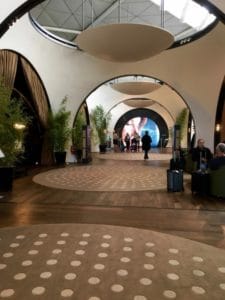 of the idiotic “travel ban” earlier in 2017 that banned laptops on flights from several Middle East countries to the US) where security agents opened up and inspected ALL carry-on items and required you to get out and turn on electronic devices. So, my suggestion? Get to the boarding gate at the boarding time printed on your boarding pass, because although you may think you’ve got plenty of time prior to them shutting the aircraft doors – there are a lot of people getting on who have to go through this screening and that holds things up. But that is just my humble opinion, of course.
of the idiotic “travel ban” earlier in 2017 that banned laptops on flights from several Middle East countries to the US) where security agents opened up and inspected ALL carry-on items and required you to get out and turn on electronic devices. So, my suggestion? Get to the boarding gate at the boarding time printed on your boarding pass, because although you may think you’ve got plenty of time prior to them shutting the aircraft doors – there are a lot of people getting on who have to go through this screening and that holds things up. But that is just my humble opinion, of course.
The flight itself was very good again – it’s certainly nice to be in Business class, and although I was not as productive as I wanted to be with my 10 hours, I managed to stay awake the whole time so as to better acclimate myself to Chicago time.

